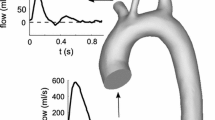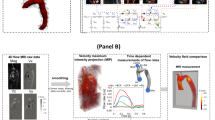Abstract
In order to assess the variability in the calculation of the pressure gradient through a moderate thoracic aortic coarctation (MTAC), a 3D finite element model of MTAC was constructed, which includes the ascending aorta, the aortic arch, the descending aorta, and the three large branches (the innominate artery, the left common carotid artery, and the left subclavian artery), as well as with a coarctation in the descending aorta. The surface model of MTAC in STL format was imported into ANSYS ICEM CFD12.1 to generate volume mesh.A finite element model suitable for hemodynamics analysis of patient-specific MTAC was established.Numerical simulation of hemodynamics in this model was performed by means of Computational fluid dynamics (CFD) using ANSYS CFX12.1. The temporal distributions of homodynamic variables such as streamlines, wall pressure, velocity vector and wall shear stress in the arteries were analyzed during a cardiac cycle. The maximum and the average of pressure gradient in a cardiac cycle through a MTAC are 13 mmHg and 2.84 mmHg respectively. The pressure difference between the systolic and the diastolic in a cardiac cycle proximal to the coarctation is about 38 mmHg, which is smaller than the difference between the recorded systolic and diastolic pressures of 115 and 65 mmHg (i.e. the difference is 115-65=50). Similarly, the pressure gradient through the coarctation under exercise conditions could be predicted via modifying the inflow and outflow boundary conditions under resting conditions. CFD techniques make it possible to obtain information (such as pressure when the patient is under exercise condition) which is difficult to get in clinic practice or in experiment based on patient-specific data.
Access this chapter
Tax calculation will be finalised at checkout
Purchases are for personal use only
Preview
Unable to display preview. Download preview PDF.
Similar content being viewed by others
References
Borghi, A., Wood, N.B., Mohiaddin, R.H., et al.: Fluid-solid interaction simulation of flow and stress pattern in thoracoabdominal aneurysms: A patient-specific study. Journal of Fluids and Structures 24, 270–280 (2008)
Cai, Y., Xu, S., Jing, Z., et al.: Effect of Geometry Configuration of Abdominal Aortic Aneurysm on Hemodynamics by 3D Numerical Analysis. Journal of Medical Biomechanics 23, 140–146 (2008)
Fu, W.Y., Meng, X.L., Gu, Z.Y., Qiao, A.K.: Construction and Analysis of Human Thoracic Aorta Based on CT Images. Journal of Beijing University of Technology 37(5), 788–793 (2011)
Hoi, Y., Woodward, S.H., Kim, M., et al.: Validation of CFD Simulations of Cerebral Aneurysms with Implication of Geometric Variations. Journal of Biomechanical Engineering 128(12), 843–851 (2006)
Shahcheragh, N., Dwyer, H.A., Cheer, A.Y., et al.: Unsteady and Three-Dimensional Simulation of Blood Flow in the Human Aortic Arch. Journal of Biomechanical Engineering 124(8), 378–387 (2002)
Canstein, C., Cachot, P., Faust, A., et al.: 3D MR Flow Analysis in Realistic Rap-id-Prototyping Model Systems of the Thoracic Aorta: Comparison with In Vivo Data and Computational Fluid Dynamics in Identical Vessel Geometries. Magnetic Resonance in Medicine 59, 535–546 (2008)
Wood, N.B., Weston, S.J., Kilner, P.J., et al.: Combined MR Imaging and CFD Simulation of Flow in the Human Descending Aorta. Journal of Magnetic Resonance Imaging 13, 699–713 (2001)
Nerem, R.M.: Vascular fluid mechanics, the arterial wall, and atherosclerosis. Journal of Biomechanical Engineering 114(3), 274–282 (1992)
Lin, Y., Jing, Z., Zhao, Z., et al.: Three Dimensional Simulation of Pulsatile Blood Flow in Human Thoracic Aorta. Academic Journal of Second Military Medical University 27(8), 867–875 (2006)
Author information
Authors and Affiliations
Editor information
Editors and Affiliations
Rights and permissions
Copyright information
© 2013 Springer-Verlag Berlin Heidelberg
About this paper
Cite this paper
Fu, W., Qiao, A. (2013). Study on Hemodynamics in Patient-Specific Thoracic Aortic Coarctation Model. In: Camara, O., Mansi, T., Pop, M., Rhode, K., Sermesant, M., Young, A. (eds) Statistical Atlases and Computational Models of the Heart. Imaging and Modelling Challenges. STACOM 2012. Lecture Notes in Computer Science, vol 7746. Springer, Berlin, Heidelberg. https://doi.org/10.1007/978-3-642-36961-2_1
Download citation
DOI: https://doi.org/10.1007/978-3-642-36961-2_1
Publisher Name: Springer, Berlin, Heidelberg
Print ISBN: 978-3-642-36960-5
Online ISBN: 978-3-642-36961-2
eBook Packages: Computer ScienceComputer Science (R0)




